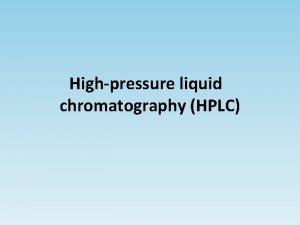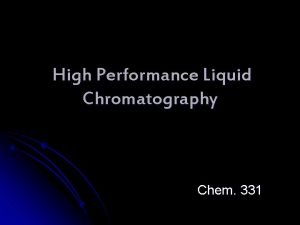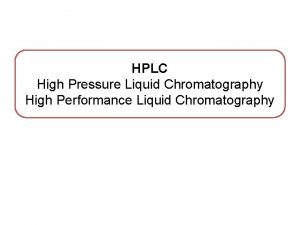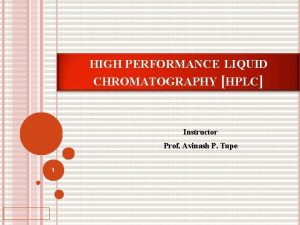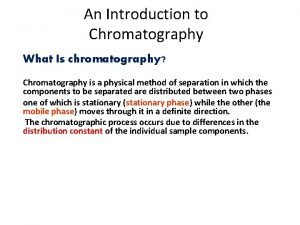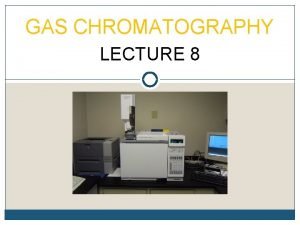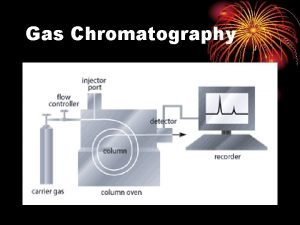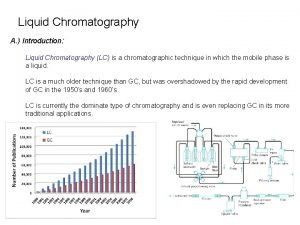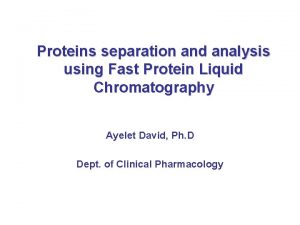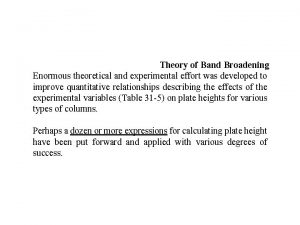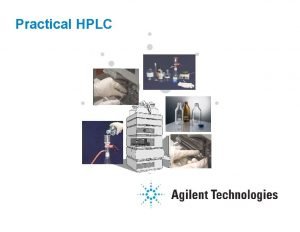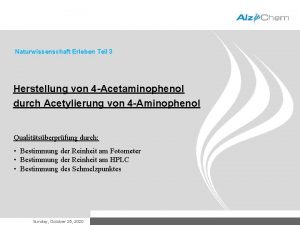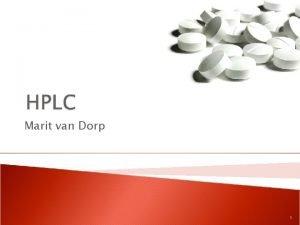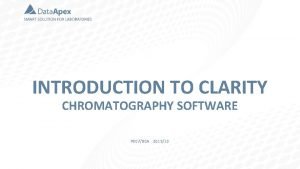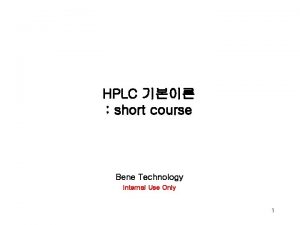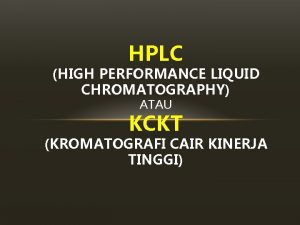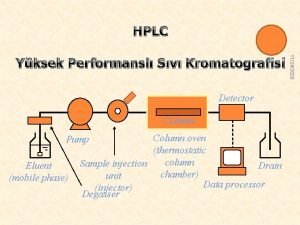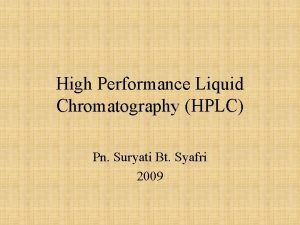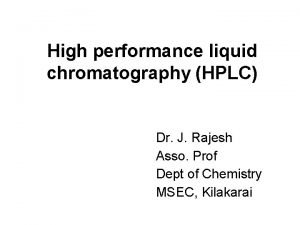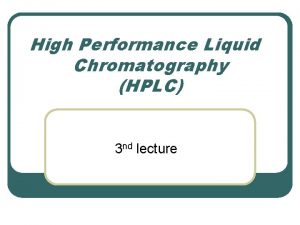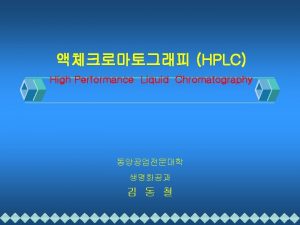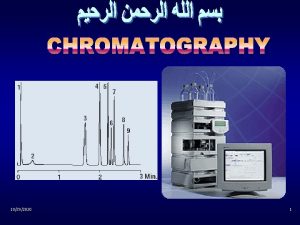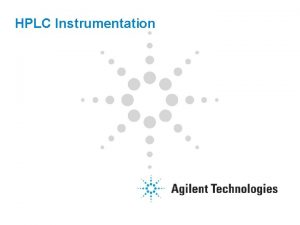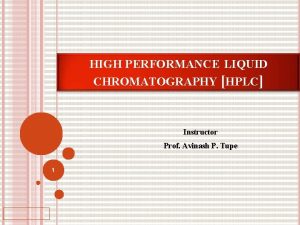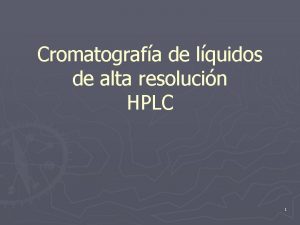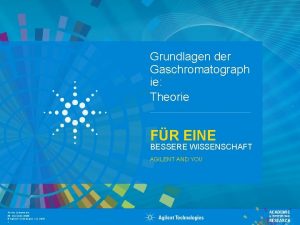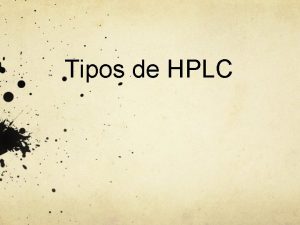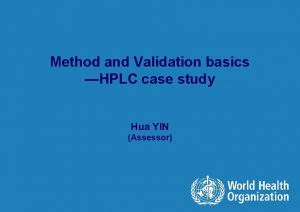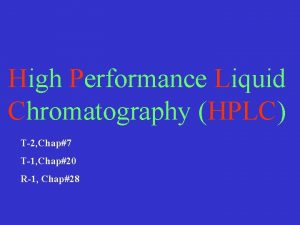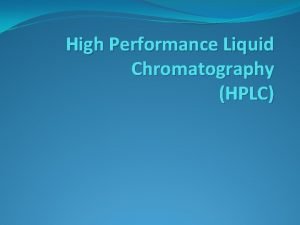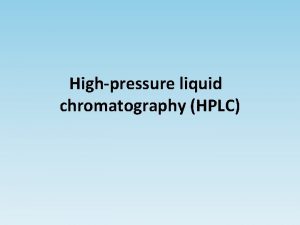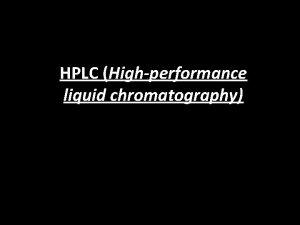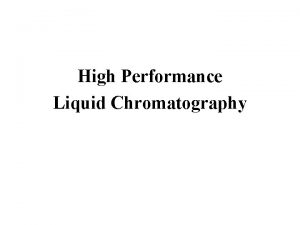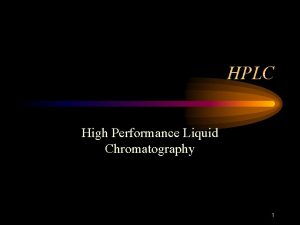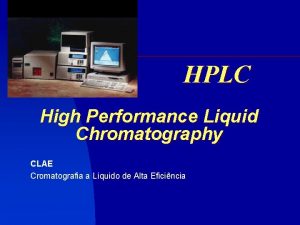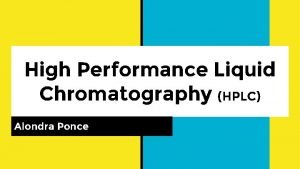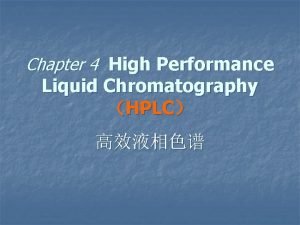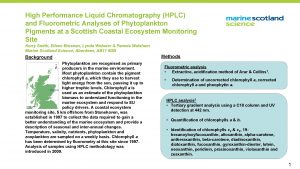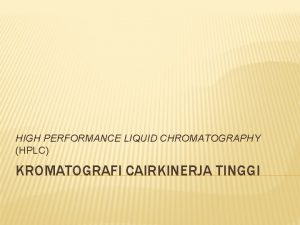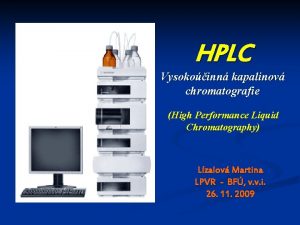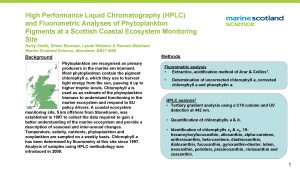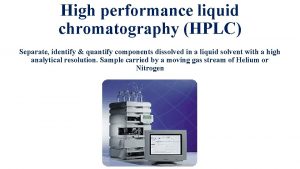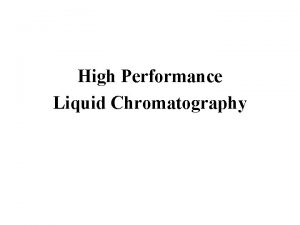High Performance Liquid Chromatography HPLC T2 Chap7 T1




































- Slides: 36

High Performance Liquid Chromatography (HPLC) T-2, Chap#7 T-1, Chap#20 R-1, Chap#28

Chromatogra phy : a group of methods to separate closely related components of complex mixture

• early chromatography was carried out in columns with diameter of 1 -5 cm and lengths of 50 -500 cm • to assure good flow rates, diameter of the particles of stationary phase was in the range 150200 μm • even the flow rates were low; thus separation time were long (several hours) • Scientists realized that major increases in column efficiency could be brought about by decreasing the particle size of packing

• the technology for producing and using matrix of diameter as small as 2 -10 μm was developed • to achieve reasonable flow rates pumping pressure of several thousand pounds per square inch are required • this requires sophisticated instruments operating at high pressures, in contrast to classical gravityflow LC • Thus HPLC • suitable for separating nonvolatile species or thermally fragile ones, sample recovery is easy

Instrumentation: a) Mobile phase reservoir b) Pump- to deliver mobile phase to the column c) Sample Injection System- to inject sample into the flowing mobile phase d) Guard column- to prevent contamination of main column e) Separating Columnf) Detector-

Schematic of HPLC apparatus Column

A) Mobile phase reservoirs: • are often equipped with a means of removing dissolved gases, Degassers, (usually O 2 and N 2) that form bubbles in the column and the detector system • degassers may consist of a vacuum pumping system, a distillation system or a system for ‘sparging’ • system also contains a mean of filtering dust and particulate matter from the solvent • it is not necessary that the degasser and filters be integral part of the HPLC system

Types of elution: a) In ‘isocratic elution’, a single solvent of constant composition is used b) Disadvantages- poor resolution of earlyeluting bands, difficult detection of late-eluting bands and long elution time c) b) In ‘gradient elution’ the compositions of the mobile phase are changed d) HPLC is often equipped with the devices that introduces solvent from two or more reservoirs into a mixing chamber at desirable rates

Improvement of separation efficiency by gradient elution

B) Pumping system: 3 types of pumps each with its own set of advantages and disadvantages 1) Reciprocating pump: consist of a small chamber in which the solvent is pumped by the back and forth motion of a motor-driven piston (90% of HPLC system) 2) Advantages: small internal volume, high output pressure, adaptability to gradient elution, constant flow rate 3) Disadvantages: produces pulsed flow which should be damped (by Pulse Damper)

2) Displacement-type pump: consist of syringe like chamber equipped with a plunger that is activated by a screw-driven mechanism powered by a stepping motor Advantages: constant flow rates, pulse free output Disadvantages: limited solvent capacity(~250 ml) 3) Pneumatic pump: the mobile phase is contained in a collapsible container housed in a vessel that can be pressurized by a compressed gas Advantages: inexpensive, pulse free output Disadvantages: not amenable to gradient elution

C) Sample Injection system: a) syringe injection through a self-sealing septum b) In stop-flow injection, the flow of the solvent is stopped momentarily, a fitting at the column head is removed, and the sample is injected directly onto the head of the column c) Using sampling loop

D) Guard Column: a short (~5 cm) column before the analytical column where they act as filters contain a stationary phase similar to that in the analytical column remove not only particulate matter and contaminant from the solvents but also sample components that bind irreversibly to the stationary phase when the guard column is contaminated it is repacked or replaced with a new one of the same type

E) Separation columns: are made up of glass-lined metal or stainless steel tubing to withstand high pressure, of various dimension most common column currently in use is one that is 25 cm in length, 4. 6 mm in inside diameter and packed with 5 um particles For exclusion chromatography, columns are 50 -100 cm long Peak response of sample is inversely proportional to the diameter of column

Types of column packing: 2 basic types a) Pellicular particle: consist of nonporous, spherical beads coated with a thin porous layer of resin b) Used largely for guard column and not for analytical column c) b) Porous particle: consist of porous microparticles (diameter 3 -10 um)

F) Detectors: 2 basic types a) Bulk property detector: respond to a mobile phase bulk property viz refractive index, dielectric constant, or density, which is modulate by the presence of solutes b) Relatively insensitive and require good temperature control c) b) Solute property detector: respond to a physical property of the solute (UV absorbance, fluorescence etc. ) that is not exhibited by the pure mobile phase

Different type of chromatography a) Adsorption chromatography b) Partition c) Ion exchange d) Gel exclusion e) Affinity

1. Adsorption Chromatography: • separation depends on a competitive interaction of mobile phase molecules and solute for adsorption sites on the surface of the column packing (adsorbent) • stationary phase is a solid (Silica and alumina) • interaction between a solute and the adsorbent is optimum when solute functional groups exactly overlap adsorption sites

Application of Adsorption Chromatography: • best suited for nonpolar and water insoluble compounds having molecular weight < 5000 • particular strength of adsorption chromatography, not shared by other methods, is its ability to differentiate among the components of isomeric mixture

2. Partition chromatography: Retention and separation occur due to the relative solubility of the analytes in the two fluids (partition coefficients) a) Liquid-liquid chromatography: a liquid stationary phase is retained on the surface of support particles by physical adsorption Disadvantages: loss of stationary phase

b) Bonded-phase chromatography: the stationary phase is bonded chemically to the support (silica) two types based on the polarities of the mobile and stationary phases: Normal-phase chromatography - stationary phase is highly polar ( H 2 O, triethyleneglycol) and the mobile phase is relatively nonpolar (hexane) Reversed-phase chromatography - stationary phase is highly nonpolar (hydrocarbon chain) and the mobile phase is relatively polar ( H 2 O, methanol or acetonitrile)

Relationship between polarity and elution time In normal phase chromatography, the least polar component is eluted first, because it is most soluble in mobile phase and increasing the polarity of the mobile phase has the effect of decreasing the elution time In contrast, in reverse-phase method, the most polar component appear first, and increasing the mobile phase polarity increases the elution time

In commercial normal-phase packing, the R in the siloxane structure is a polar functional group such as cyano(-C 2 H 4 CN), diol (-C 3 H 6 OCH 2 CHOHCH 2 OH), amino(-C 3 H 6 NH 2), and dimethylamino (C 3 H 6 N(CH 3)2) In commercial reversed-phase packing, the R in the siloxane structure is a C 8 chain(n-octyl) or C 18 chain(n-octyldecyl) Longer alkyl chain produces packings that are more retentive and permit the use of large samples

Application of Partition Chromatography: Soft drink additives Organophosphate insecticides

Derivatization: In some instances, it is useful to convert the components of a sample to a derivative before or after separation a) to reduce the polarity of the species so that partition rather than adsorption or ion-exchange columns can be used b) to increase the detector response and thus sensitivity, for all the sample components c) to selectively enhance the detector response to certain components of the sample (Fluorescence derivatization)

Chromatogram of orthophthaladehyde derivative of 30 aminoacids of physiological importance

Ion-Pair (or Paired-Ion) Chromatography: a type of reversed-phase partition chromatography used for the separation of ionic species the mobile phase consist of an buffer containing an organic solvent (methanol or acetonitrile) + an ionic compound containing a counter ion of opposite charge to the analyte A counter ion combines with the analyte to form an ion pair, which is a neutral species that is retained by a reversed-phase packing

Most of the counter ions contain alkyl groups to enhance retention of the resulting ion pair on the nonpolar stationary phase Bound ion pairs is then eluted with elution buffer Applications of ion-pair chromatography overlap those of ion-exchange chromatography

3) Ion-Exchange Chromatography: carried out with matrix bearing charged functional groups (+ve or –ve) Solute ions of the opposite charge in the mobile phase are attracted to the matrix by electrostatic forces Negatively charged group bearing matrix are used for exchanging +ve charge species and vise versa

Functional groups of IE resins: Cation exchangers Anion exchangers

Application of Ion-Exchange Chromatography: • applied to a variety of organic and biochemical systems including drugs and their metabolite, serums, food preservatives vitamin mixtures, sugars etc

4) Size-Exclusion Chromatography: also c/a gel permeation or filtration chromatography gel particles contains a network of uniform pores into which solute and solvent molecules diffuses very large molecules cannot enter many of the pores, thus excluded, elute at the void volume of the mobile phase


Application of Size Exclusion Chromatography: • separation of high-molecular-weight, natural product molecules form low-molecular-weight species and salts Ex separation of proteins from peptides and aminoacids • Separation of homologs and oligomers: Ex separation of a series of fatty acids

5) Affinity Chromatography: • the most selective type of chromatography • involves covalent attachment of an “ligand” to a solid support • only the solute that have affinity for the ligand is retained Affinity Ligands: can be antibodies, enzyme inhibitors, or other molecules that reversibly and selectively bind to the analyte molecules in the sample

bound solute can be eluted from the column by adding : excess ligand to the mobile phase or compound that interfere with solute-ligand interactions
 High performance liquid chromatography hplc machine
High performance liquid chromatography hplc machine Hplc chromatography introduction
Hplc chromatography introduction Liquid chromatography definition
Liquid chromatography definition Hplc vs gas chromatography
Hplc vs gas chromatography Hplc principle
Hplc principle Chromatography what is
Chromatography what is Principle gas chromatography
Principle gas chromatography Gas liquid chromatography
Gas liquid chromatography Liquid chromatography definition
Liquid chromatography definition Kav chromatography
Kav chromatography Conduction and breakdown in pure liquids
Conduction and breakdown in pure liquids Sieve tray tower
Sieve tray tower Band broadening in hplc
Band broadening in hplc Priming hplc
Priming hplc Rührapparatur
Rührapparatur Hplc werking
Hplc werking Adsorption chromatography
Adsorption chromatography Clarity hplc software
Clarity hplc software Internal use only
Internal use only Hplc reverse phase vs normal phase
Hplc reverse phase vs normal phase Prinsip kckt
Prinsip kckt Hplc cihazı kısımları
Hplc cihazı kısımları Hplc principle
Hplc principle Advantages of hplc
Advantages of hplc Hplc lecture
Hplc lecture Theory of chromatography
Theory of chromatography Hplc lc 차이
Hplc lc 차이 Stationary phase and mobile phase in hplc
Stationary phase and mobile phase in hplc Hplc detector types
Hplc detector types Hplc instrumentation diagram
Hplc instrumentation diagram Block diagram of hplc
Block diagram of hplc Problemas comunes en hplc
Problemas comunes en hplc Nombre de plateaux théoriques hplc
Nombre de plateaux théoriques hplc Hplc basic principle
Hplc basic principle Van deemter gleichung
Van deemter gleichung Cromatografia normal
Cromatografia normal Rrf in hplc
Rrf in hplc

